
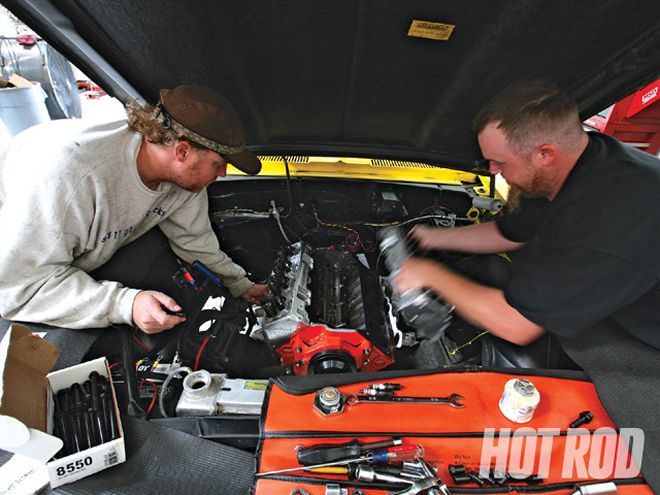 Our E-Street versus Vortec head swap was executed in the same weather conditions for true back-to-back results. Nothing changed on the engine other than the heads themselves. We used Edelbrock Air-Gap dual-plane intake manifolds, which have the same port design in the Vortec and standard versions.
Our E-Street versus Vortec head swap was executed in the same weather conditions for true back-to-back results. Nothing changed on the engine other than the heads themselves. We used Edelbrock Air-Gap dual-plane intake manifolds, which have the same port design in the Vortec and standard versions.
This comes at the right time. Edelbrock has introduced its E-Street cylinder heads, a new line of lower-priced stuff to combat the knock-offs and the legit competitors that use Chinese castings. The E-Street heads are cast and assembled at Edelbrock facilities in California, USA, and are currently available for small-block Chevys and Fords. We asked if Mopar versions were coming soon: negatory.
The E-Street line is marketed for applications under 400 hp and 5,500 rpm. The heads appear to us to use Edelbrock's Performer RPM castings but without all the finish work and hand-blending used in the higher-cost heads. Less costly valvetrain components are used, though features such as Helicoiled rocker-stud bosses are retained. The main things limiting the rpm potential are the valvesprings, which are intended for small, flat-tappet cams; they're 1.250 in diameter and cannot handle more than 0.550-inch lift (in fact, we'd keep it closer to 0.520). Machining would be required to install larger-diameter springs. The E-Street heads are not smog-legal, as the Performer heads are.
At press time, Summit Racing's nonsale price for a pair of fully assembled E-Street heads for a small Chevy was $949.95 and the Fords were $973.95. That makes them $170 to $239 less than a set of Edelbrock Performer heads.
To test the Chevy version of the E-Street heads, we compared them against GM's Vortec heads, which we consider the all-time kings of small-block bang for the buck.
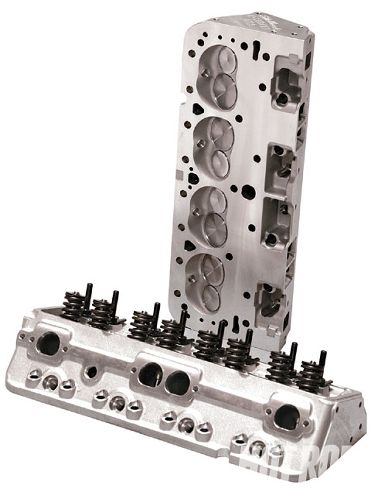 Edelbrock's new lower-buck E-Street heads are available for Chevys (shown) at $949.95 or small Fords ($973.95). The Ford heads have 170cc intake runners, 60cc chamber volumes, 1.60-inch exhaust valves, and your choice of 1.90- or 2.02-inch intake valves.
Edelbrock's new lower-buck E-Street heads are available for Chevys (shown) at $949.95 or small Fords ($973.95). The Ford heads have 170cc intake runners, 60cc chamber volumes, 1.60-inch exhaust valves, and your choice of 1.90- or 2.02-inch intake valves.
E-Street vs. Vortec Price Comparo
Complete, assembled, un-modified Vortec heads (PN 12558060) are sold by Summit Racing for $299.95 each. However, those heads tend to be limited to between 0.420- and 0.470-inch lift depending on whom you ask and what head you're holding. The problem is that the valvespring retainer contacts the top of the valve seal at high lifts. Some say Vortec heads can go to 0.500 lift just by changing to umbrella-type seals, but if you are also upgrading the springs, then the easiest, most affordable option is the premodified heads from Scoggin-Dickey Performance Center for $389.95 each (PN SD8060A2). Those have machined valveguides and so-called Z28 springs good for 0.525-inch lift, and they're $170 cheaper than the E-Streets.
While it probably won't matter with cam profiles under 0.500 lift, the downside could be that the Scoggin-Dickey modified Vortecs described above still have press-in rocker studs, while the E-Streets are screw-in. Likewise, the E-Street heads come with pushrod guideplates, while the Vortecs require guided rocker arms. However, for Vortec heads with the valve-spring upgrade and also the screw-in studs with guideplates, Scoggin-Dickey charges $424.95 per complete head (PN SD8060AGP2). A pair of these modified Vortecs with guideplates is just $100.05 cheaper than the E-Street heads.
However, there are other costs to consider. If you do not opt for guideplates on your Vortec heads, you'll need self-aligning rocker arms. You could use junkyard stamped-steel parts or buy GM's set of 16 stock arms for $55.95 (PN 12495490). If you want roller rockers, shop carefully: Some self-aligning versions are more expensive than the standard versions, others are about the same. On the other hand, if you do use guideplates, then you'll need hardened pushrods, which are $50 to $100 more than standard ones. (See the captions for a tip on how we removed the guideplates and used cheaper standard pushrods and guided rockers with our E-Street heads.)
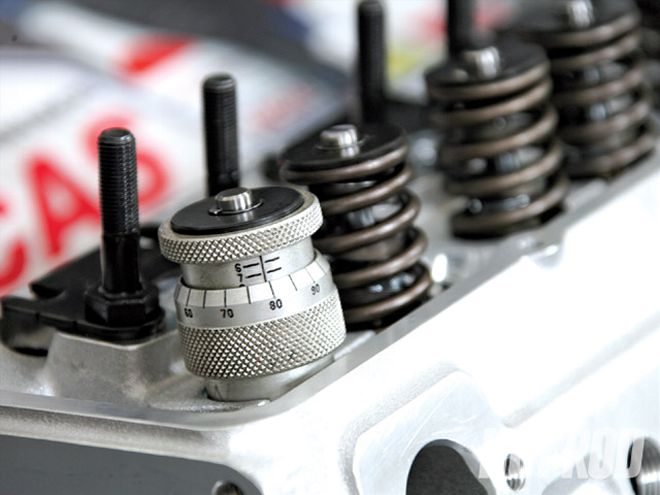 We measured the valvespring installed height and found it to be nearly 1.800 inches with the hardened spring seats installed. The valvesprings are 1.250 inches in diameter, and not even a 1.270-incher will fit the heads without machining. The spring pressures were 140 pounds on the seat and 320 at 0.500 lift.
We measured the valvespring installed height and found it to be nearly 1.800 inches with the hardened spring seats installed. The valvesprings are 1.250 inches in diameter, and not even a 1.270-incher will fit the heads without machining. The spring pressures were 140 pounds on the seat and 320 at 0.500 lift.
But there's more. The Vortec requires a special intake manifold, but the Edelbrock heads use the conventional setup. Depending on the intake you pick, the Vortec version can be $18 to $47 more expensive. (Scoggin-Dickey has packages that include modified Vortec heads and Edelbrock intakes for great prices, though.) The special Vortec intake gaskets are slightly more money than standard ones, but prices on them have come down in recent years. Vortec-style center-bolt valve covers, however, can still be significantly more costly than the old perimeter-bolt style, depending on the style you choose.
All told, if you're buying all the parts new, either setup is about the same money give or take $200. But what about the performance?
The Performance Test
First, we weighed both heads: The aluminum Edelbrocks are at a 40-pound advantage from the get-go.
Next, we strapped each head to the Superflow flow bench at Westech Performance Center; the numbers are published in the chart seen with this story, and they reveal that the Edelbrock heads are just a few cfm better than the Vortecs at a few valve lift points. Since the E-Street Chevy heads have 185cc intake runners and the Vortecs are 170 cc, the common bench-racing theory is that the smaller ports in the Vortecs would create higher air speed and should therefore run better. We'll see.
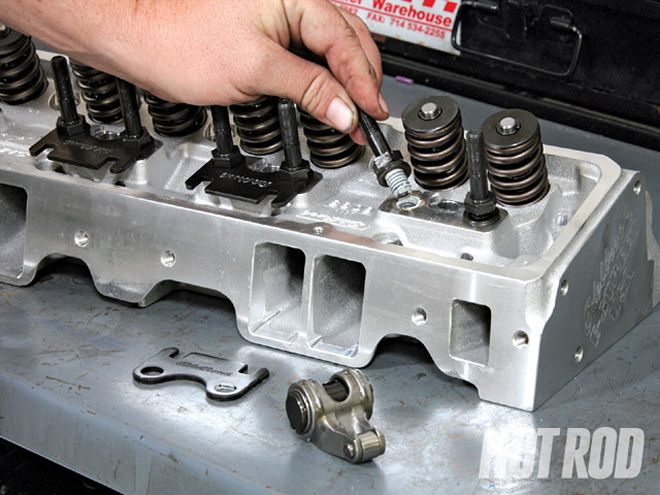 Since our 383 engine was already running with Vortec heads that used guided rocker arms, no guideplates, and standard (not hardened) pushrods, we decided to reuse those parts. The E-Street heads come with pushrod guideplates that are 0.125 inch thick. That's the same thickness of the head-bolt washers we placed under the rocker studs after removing the guideplates, allowing us to use our old Vortec valvetrain on the E-Street heads. The rocker studs are 3/8 inch.
Since our 383 engine was already running with Vortec heads that used guided rocker arms, no guideplates, and standard (not hardened) pushrods, we decided to reuse those parts. The E-Street heads come with pushrod guideplates that are 0.125 inch thick. That's the same thickness of the head-bolt washers we placed under the rocker studs after removing the guideplates, allowing us to use our old Vortec valvetrain on the E-Street heads. The rocker studs are 3/8 inch.
The implement of horsepower we tested was a GM Performance Parts HT383 crate engine installed in our Crusher Camaro. This engine retained its stock Vortec heads (PN 12558060; we have modified them for increased lift) topped with an Edelbrock Air-Gap intake and an old-school Holley 4779 750-cfm double-pump carb. We had 13?4-inch open headers on it with 18-inch collector extensions. For this test, we went against our nature and decammed the engine, instal-ling a stock ZZ4 crate engine hydraulic roller with specs of 208/221 at 0.050, 0.474/0.510-inch lift and a 112-degree lobe-separation angle.
Since we tested using Westech's Superflow chassis dyno, running in unloaded mode, you should know the balance of the drivetrain, which is a TH400 with a B&M Holeshot converter, a Ford 9-inch with 4.57 gears, and Hoosier 30x9.50 radial slicks.
The converter didn't fully grab the engine until about 4,500 rpm, and we suspect this engine's torque peak is at a lower rpm point, so we don't have clear data there. The chassis dyno reported a torque peak right at the point of converter near-lockup at 4,500 to 4,600 rpm. With the Vortec heads in place, that number was 323 lb-ft, and the horsepower peak was 298 at 5,300 rpm.
The Edelbrock heads show-ed an improvement with numbers of 342 lb-ft at 4,500 rpm and a power peak of 305 hp at 5,400 rpm. Interestingly, while the power curve with the Vortec heads rolled over hard right after peak power, the Edelbrock heads saw a flatter roll-off, carrying decent power through 5,800. At that point, the Edelbrock heads made 20 more rwhp than the Vortecs.
Conclusions
If there's any downside to the E-Streets, it's that they come with scrawny valvesprings that will limit your cam selection to small flat-tappet grinds or very small hydraulic rollers such as the one we used. If you want to upgrade the cam later and need better springs, the price of the machine work required to open up the spring seats is high enough that you might as well buy a different cylinder head to start with.
However, even at a total head/intake/valvetrain package price of perhaps $200 more than the Vortec iron heads, the Edelbrock E-Street heads seem to be the better. They weigh less and make more top-end power. The E-Streets are a good call for tame engines.
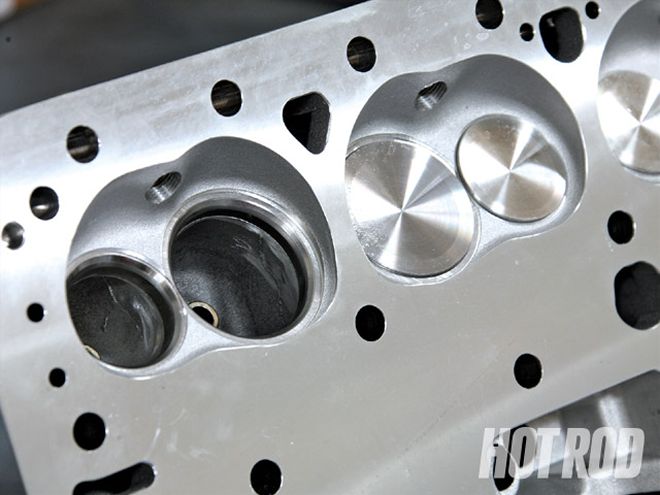
Interestingly, the E-Street heads required the carb jets to be stepped up four sizes to deliver the same air/fuel ratios as the Vortec heads. We think that may be because the Vortec heads have more efficient chambers. Some will argue it's due to the greater heat dissipation of the aluminum heads as compared with the iron heads, but that's a theory that has not been proven to us. The Chevy E-Streets use 2.02/1.60-inch valves.
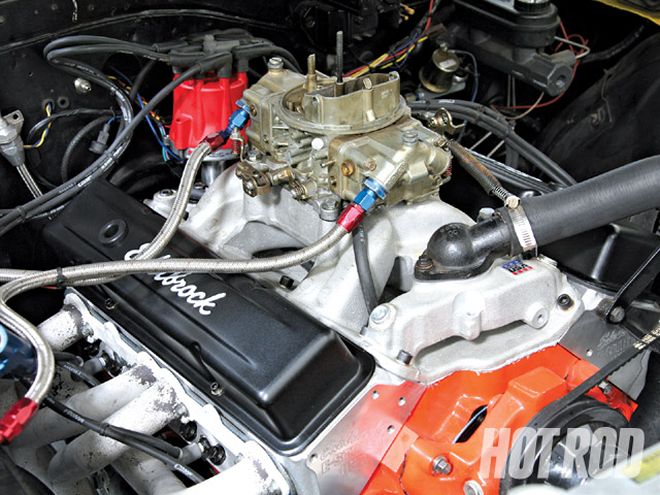
Here's the HT383 crate engine in our car after the E-Street swap. The valve covers are Edelbrock's affordable stamped-steel units in the newer matte-black finish. We like 'em.
The Flow Test
Both heads were tested on a Superflow bench at 28 inches of pressure drop using the valves provided with the heads. The E-Street heads use 2.02/1.60 valves, while the Vortecs are 1.94/1.60. A flow tube was used on the exhaust side and a radiused entry was used on the intake.